Razer Lycosa Gaming Keyboard Review
Razer Lycosa Gaming Keyboard
The Lycosa is the smaller cousin to Razer's Tarantula Gaming Keyboard. Does it have enough bite to make a quick meal of its rivals?
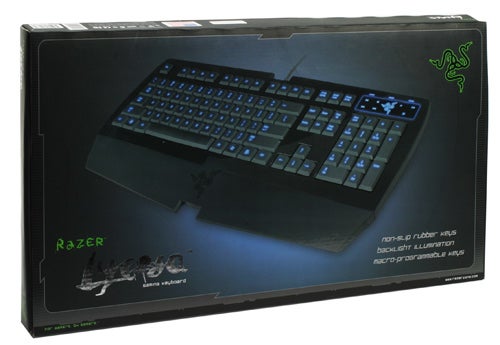
Verdict
Key Specifications
- Review Price: £56.21
It seems strange to me that no company in the history of gaming keyboards has yet come up with the perfect one. Every effort that comes along is flawed in some way, and I’ve spent unhealthily large portions of time wishing some manufacturer would just combine all of the good aspects of its competitors’ products while avoiding the pitfalls.
Razer is a name that implies much: at the cutting edge, razor-sharp performance, razing the enemy and sometimes, a close shave. Those who know the company a little will probably think of mice, as at one time Razer’s name was synonymous with (arguably) the best gaming mice money could buy. But while it still makes excellent mice, they are no longer the all-conquering rodents of yesteryear, and models from the likes of SteelSeries and Logitech have more than caught up. So Razer has diversified, now choosing to manufacture gaming keyboards too. 
Apart from a few collaborative efforts, its main candidate untill recently was the Tarantula, which despite receiving generally positive reviews failed to rise above the pack. Now Razer has a new contender which goes by the name Lycosa – actually a type of Tarantula. This naming scheme suggest some inferiority to its older brother, and indeed the Lycosa is smaller, cheaper and has fewer buttons. But it also has some features that its sibling lacks.
According to Razer’s packaging, which is impressive as usual, the Lycosa lets you exist at the ‘nexus of dominion’. Some of the features on hand to help you do so include macro-programmable, non-slip rubber keys, backlight illumination (with a WASD cluster lighting option) and the essential option of a gaming mode that deactivates the Windows key.
The keyboard is well protected in a soft plastic bag, and it needs to be – everything I review these days seems to sport a shiny piano-black mirror finish, and the Lycosa is no exception. While it does look lovely, and forms the perfect contrast to the matte, rubberised keys, it also means you’ll have to have regular fingerprint and smudge cleaning sessions, and it would have been nice if Razer had included a cleaning cloth with its premium-priced product.
Let me just say this much about Razer gear: most people will find it at least remotely attractive. The company has a healthy obsession with the colour black, usually complemented by funky blue LED lighting (unlike the gaudy orange that some use – Logitech, you used to be true to blue). At fist glance, the thing that might strike you most about the Lycosa is its beautiful simplicity.
The Lycosa features smooth, sharp lines all around, which are only broken by central cut-outs at the top and bottom. The entire board is a stylish two-tone affair, and the key layout is one of the cleanest I have seen on any gaming keyboard in years. Let me clarify: apart from an out-of-the-way, modest little panel of touch-controls just above the number pad, there is not a single key that you wouldn’t find on an IBM keyboard from 1993. But it’s a gaming keyboard, right? What about macro keys? Function buttons? Media controls?
While the minimalist layout is really refreshing, dedicated keys are not simply a gimmick on most gaming keyboards – they’re there for a reason, and usually a damn good one. Simple is not always uncomplicated and uncluttered: sometimes it’s just not advanced. But then there are users out there who would claim the standard layout is all a hardcore gamer really needs (albeit usually the crowd to whom World of Warcraft is an anathema). Razer, however, gives this argument far more weight than it might otherwise warrant, by utilising some rather clever software. 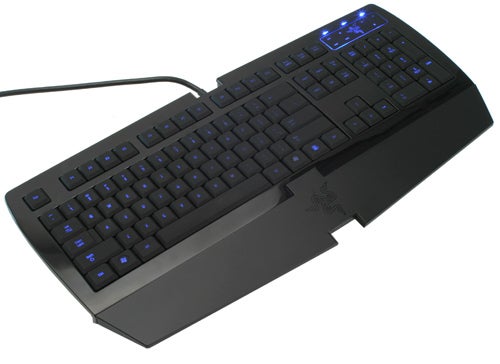
What Razer’s driver does is make the entire keyboard programmable. Basically, every key you see is a potential macro key. As far as we at the office are aware, it’s a feature that’s unique to Razer – and it shouldn’t be. Hardware manufacturers are always harping on about how gaming hardware is all about customisation, and then curtail our options by not offering as much of it as they could, even at the software level.
This doesn’t alter the fact that, due to a complete absence of dedicated buttons, with the Lycosa the software is a necessity; but it does go a large way toward making up for it. Personally, I would rather have a fully programmable keyboard than a few custom macro keys, though I’d obviously prefer to have both. And though the Lycosa would have been helped by the addition of even a single button to act as macro-shift, you can always find one you never use (my victim being Print Screen) and employ that.
Still, thanks to the included software (and ten switchable profiles) Razer’s latest effort is one incredibly versatile keyboard, not just for gaming use but also for Photoshop and other complex programs. The software’s also very easy to use. You get a visual representation of the Lycosa with its blue backlighting, where keys turn red when you hover over them with the mouse. Then simply click and you’re ready to macro, with the ability to record up to 17 individual keystrokes.
As far as media controls are concerned, the Lycosa is simply too smooth for keys. As I mentioned earlier, you’ll find a touch-sensitive panel above the number pad, which regular readers might know is not something I tend to be enthusiastic about. It sure looks stylish however, especially the Razer logo, which is itself a button. It includes the usual play/stop/skip and volume controls, and a backlight mode switch. 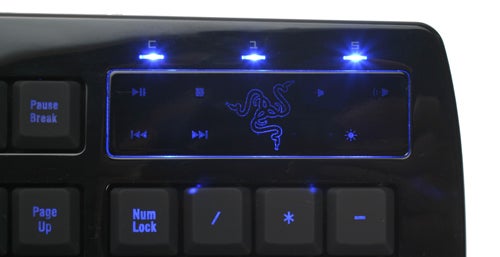
Here is where the problems start. Quite apart from being too close together, the controls, much like the rest of the keyboard, are hard to make out because the lighting is simply too dim – far more so than on competing products. Since the Lycosa’s key-symbols are not painted but purely transparent, they can be very tricky to distinguish. For touch-typists this will not be a problem, and many gamers will know the locations of their favourite keys by heart, but for everyone else this could well be a major annoyance during daytime use.
There are three backlighting modes: off, on (all keys) and gamer (WASD only). The brighter gamer setting, unlike the normal one, is clearly visible under any amount of ambient light. I can’t help but think that Razer would have been better off combining the gaming and normal modes into a slightly usable single one.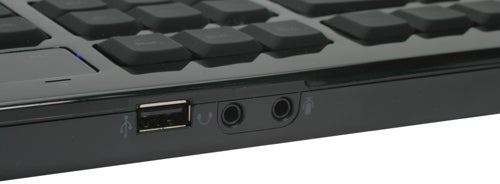
Like any self-respecting gaming board, the Lycosa offers a hardware switch to deactivate the Windows key, though the process is the most convoluted I’ve come across. You need to touch the Razer logo and press the Windows key at the same time, but due to the touch-sensitive nature of the logo you have no tactile feedback, and there is no indicator to tell if you’ve succeeded, meaning you need to test before you play.
There are microphone and 3.5mm audio ports, and an integrated USB port, which doesn’t win you any ports because it’s simply a pass-through; there’s another connector for it alongside that used for the keyboard. That’s arguably a good thing though. After all, you wouldn’t want another peripheral eating up your pro-gaming keyboard’s 1000Hz Ultrapolling™ bandwidth and power. Another advantage to this system is that it offers full USB 2.0 speed, while many competitors (including Razer’s own Tarantula) only caters to the older, slower 1.1 standard. The USB port could be handy if, for example, you’re using a USB headset and don’t want to reach behind your PC to plug it in.
The Lycosa also has a feature called anti-ghosting, meaning (as entirely unimplied by the name) it can register up to ten simultaneous key-presses. This can be a genuinely useful feature, especially in complicated FPSs like Crysis. Though rather than applying to the entire keyboard, as with the Tarantula, this model only supports a ‘gaming cluster’ – hope this extends beyond just WASD!
Ergonomically, the keyboard uses the same flat profile that was introduced by Logitech way back when, and has since been copied by many other manufacturers. Of course, if this is not your cup of tea, there are two feet that elevate the board, but this does affect stability, while in its flat position the Lycosa won’t slide, no matter how you abuse it. The wrist-rest, meanwhile, is quite comfortable, though I prefer Logitech’s perforated examples. It is finished in a softer plastic the same colour as the keys, and securely attached by four screws.
A cut-out on the top of the board is mirrored by one in the wrist-rest’s centre, in the exact location where your right hand will rest during typing – which means it’s a less comfortable experience than it could have been. Though it does make wrapping cables around the board easier for convenient transport, just one notch would have done this job adequately without the ergonomic discomfort.
The keys are comfortable, and the non-slip rubberised finish works well – perhaps a little too well for typing, where switching between keys feels just a tad muddy. And though low-profile keys seem like a good idea, most of us at the office didn’t like their feedback. If I had to sum it up after an initial test, I would have said cheap and noisy – but I admit that the response has grown on me in the interim, and those who like their keyboard to respond with an audible and tactile ‘click’ upon a key-press will like the Lycosa. 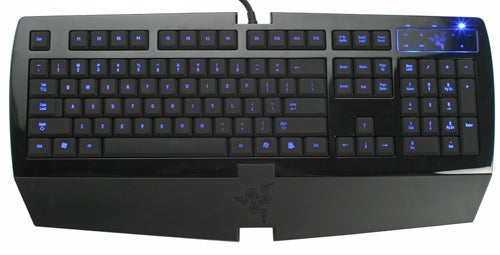
Ultimately though, the Lycosa is a gaming keyboard and while, yes, one needs to be able to type on it, that’s a secondary consideration. For gaming, the finish works perfectly, while the noisy feedback is not as much of a hindrance, and though I do miss dedicated function and macro keys, having the entire keyboard as your playground makes up for this. The low profile nature is very much a matter of taste, but is at least as responsive as any other gaming keyboard I’ve used, and I must admit the feel of it grew on me.
Crucially though, if you’re reading this review, you’re probably in the market for a gaming keyboard; and to put it bluntly, there are better alternatives out there for the price. While the Lycosa has grown on me, I still prefer some of the full-depth alternatives like Logitech’s G15. And not just in terms of feel. Basically, you have to really want the Lycosa’s looks or minimalist experience when Logitech’s alternative offers better backlighting, easier deactivation of the windows key, dedicated macro-keys and hardware macro programming in addition to an LCD screen for the same outlay.
”’Verdict”’
I really wanted to like the Razer Lycosa, for its svelte looks, blue backlighting, and for daring to eschew any dedicated gaming keys. And after a while I did, as the smaller sibling to the Tarantula it overcame initial dislike to offer up an average typing experience and an above average gaming one. But the experience is marred by several flaws, meaning that unless you feel a particular affinity for the rubberised, laptop-like keys or the ability to macro-program any key, there are better options out there for the money.
Trusted Score
Score in detail
-
Value 7
-
Features 7
-
Design 8

